Methods of drilling wells: technological principles and features of the main methods
The construction of a water intake well involves the use of various drilling methods. Loose and water-saturated soils are removed using a bailer. For drilling through clay and rock formations, well drilling methods based on the rotational and vibration principle are used.
The work involves mechanisms that allow the development of soils of various types and to different depths. We will tell you how to choose the optimal drilling technology that allows you to quickly and flawlessly complete the excavation for the water intake device.
To visually present the information we offer, the text is supplemented with useful diagrams, photo collections, and video tutorials.
The content of the article:
Types of drilling methods
Previously, drilling of water-bearing wells for personal use was carried out mainly manually. This was a labor-intensive and lengthy process, so not every owner of a plot or cottage could boast of having their own source of water supply.
Gradually, mechanized drilling replaced manual methods due to the significant facilitation and acceleration of the process.
Today, almost all aquifer wells are drilled using a mechanized method, which is based on the destruction of soil, supplying it to the surface in one of two ways: dry, when waste soil is removed from the well using mechanisms, and hydraulic, when it is washed out with water supplied under pressure or gravity.
There are three main methods of mechanical drilling:
- Rotational (the soil is developed by rotation).
- Shock (the drilling projectile destroys the soil with impacts).
- Vibrating (the soil is developed by high-frequency vibrations).
The rotational method is considered the most highly productive, 3-5 times more efficient than the shock method and 5-10 times more efficient than the vibration method. In addition, the rotational method is the most inexpensive and accessible; it is often used as the main method of manual drilling.
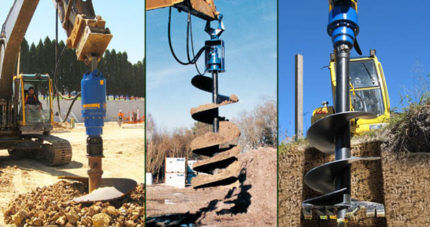
In turn, the rotary drilling method, widely used for the construction of water wells, is divided into four main types of drilling:
- core;
- screw;
- shock-rope;
- rotary.
Each type of rotary drilling has its own characteristics and is performed with equipment specially designed for this purpose. Let's look at these types of drilling in more detail, determine what their differences are and what method needs to be used in each specific case.
Specifics of core drilling
Core drilling is a mechanical rotational method in which clayey or dense sandy soil is extracted in the form of a cylindrical core. A core drill is a thick-walled metal pipe.
At the top of the core drill there is a device for attaching rods necessary for extending the drill string. Below is a crown, the type of which is selected depending on the category of soil to be drilled.
When driving using the core method, the soil is destroyed by a ring-shaped crown. The inner part of the core is preserved in an undamaged form. To facilitate the drilling process in hard and semi-solid loams, clays, and rocks, a drilling fluid is supplied to the bottom hole.
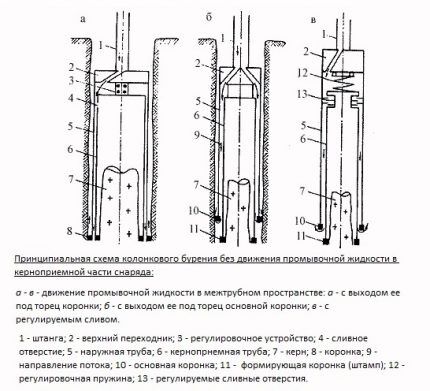
Sludge from the face is sometimes removed by flushing - by injecting a large amount of water into the production shaft. Most often, flushing is replaced by blowing with compressed air supplied by a compressor inside the pipe.This type of drilling allows you to drill wells with a depth of up to 1000 meters and a diameter of 8 to 20 cm.
Mechanical core drilling is carried out using drilling rigs such as ZIF, UGB, UKB, mounted on vehicles such as KAMAZ, KrAZ, skidders, etc. In the version for manual drilling The core pipe is shortened and called a bell or glass. The core pipe is structurally similar to the last, upside-down household item.
Core drilling is used in the following cases:
- geological exploration of mineral resources;
- drilling of exploratory wells;
- construction of water-bearing wells of any depth, including filterless wells in rocks.
For device private water wells in some cases, the core method is used before starting auger or rotary drilling, simultaneously performing an exploration and preparatory role.
In the construction of private wells, core drilling is used in combination with percussion-rope drilling. The clay layers are passed through a core pipe. Loose sands, gravel and pebbles with sand filler, which do not remain in the core pipe, are removed from the shaft by zhelonization.
In terms of efficiency, the core method is somewhat inferior to the auger method of drilling water intake wells. An auger drills faster, but it does not allow the shaft to be completely freed from the drilled rock. They are rarely used in pairs. And if it happens, then the first few meters are covered with an auger.

Equipment and tools used
The following tools are used for core drilling:
- drill bits made of diamond or other carbide material (steel, tungsten, pobedit);
- core pipe;
- pipe for sludge removal;
- rods required for extending the drill string;
- coupling connections, adapters between pipes, flushing gland.
When drilling in rock formations, the drill bit wears out quickly and must be replaced. The crown material is expensive and can withstand enormous loads; diamond drilling options are the most widespread.
All tools used during the drilling process must be aligned, i.e. be located exactly relative to the drilling axis.
Core drilling technology
The main feature of core drilling is the passage of rock with its complete preservation in the core pipe. Those. When drilling equipment operates, the crown destroys the soil in a ring, which, as it goes deeper, is pushed into the core pipe and is held in it due to its own density.
When removing the filled pipe from the mine shaft, it is freed from the core by tapping it with a sledgehammer.
The step-by-step core drilling process is as follows:
- the drill bit is connected to the core pipe;
- the core pipe is connected to rods, which increase as they deepen;
- the upper rod is fixed in the drilling rig;
- the drilling machine rotates the drill string and gradually “screws” it into the ground;
- the core pipe is gradually filled with core - soil jammed in its cavity;
- after drilling 50 - 70 cm, the drill string is removed to the surface, the rods are disconnected one by one until the core pipe is removed;
- the pipe is freed from drilled rock;
- the emptied projectile is again lowered to the bottom, extending the drill string with rods.
The actions are carried out in the described order until the well penetrates the aquifer and penetrates 50 cm into the underlying waterproof rock.
If fixing the upper aquifer is not the purpose of excavation, then the upper layers can be drill with flushing. In this case, the pump sells the flushing solution through a hose into the pipes. The solution then brings the mined-out soil to the surface.
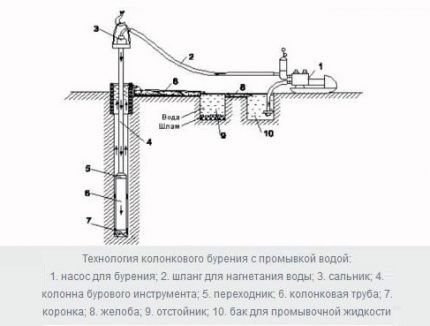
Strong advantages and disadvantages
Compared to the percussion-rope and rotary methods of mechanical drilling, core drilling is performed quite quickly, significantly reducing the time of work. Its main disadvantage is the inability to lift loose soils and pebbles saturated with water. It moves slowly through rock, requiring a chisel to penetrate boulders.
The advantages of core drilling include:
- high productivity and the ability to drill wells with a depth of over 100 m;
- reduction of loads on drilling equipment due to the destruction of clay rock, comparable to cutting it out;
- possibility of using a mobile drilling rig of compact dimensions.
Core drilling is one of the fastest methods for developing water intake workings. A sand well can be drilled using it in one working day. Under development manual water intake will take much more time.
Features of auger drilling
This type of drilling today is most often used when constructing water-bearing wells in private households. A special feature of auger drilling is that the rock being mined is completely removed from the well site without the use of additional equipment. The method resembles screwing in and allows you to drill to depth and simultaneously remove unnecessary soil.
The tool used for drilling is called an auger. It is a metal rod with blades. Screwing into the ground, the auger destroys the rock that lingers on its blades. Due to the specific design of the auger, it is impossible to completely free the face from the dump. Therefore, it is mainly used for penetration of upper layers.
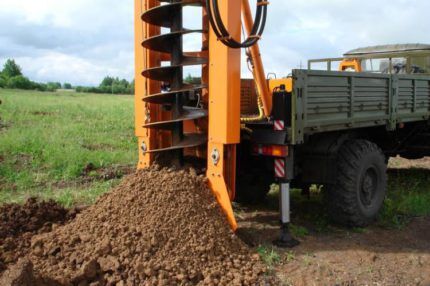
Drilling using an auger does not require much effort and financial costs, so the scope of application of this method is quite wide: geological exploration wells, laying communications, constructing drilled wells and partially water drilling.
It is now actively used for constructing Abyssinian wells, so as not to completely drive the needle well into dense soil, but to slightly facilitate the process of immersing the shaft into previously destroyed rock.
The method is suitable for developing water-bearing wells up to 30 m deep on soft and loose soils and up to 20 m on medium-dense soils. After drilling with an auger and installing the casing, the wellbore must be cleared of unextracted rock with a bailer.
The auger is absolutely not suitable for working in rocky areas! It is used for partial drilling of wells up to 120 m, while this method is combined with others: rotary, shock-rope, core.
Equipment and tools involved
Auger drilling is carried out using a drilling rig, the main element of which is a screw-type drilling tool made of high-strength metal. The drill string is expanded with equal size augers as it goes deeper.
The kit sometimes includes blade bits, which are necessary for the passage of loose rocks, as well as bits with round or cone-shaped heads, used for the development of hard rocks.
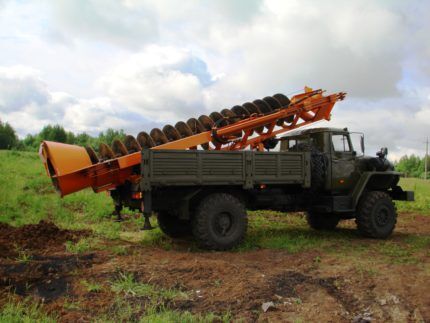
Most modern drilling rigs are equipped with hollow assemblies equipped with reversible locks that prevent the tool from moving in the opposite direction.
During the drilling process, the cutting parts of the auger are cooled by the developed soil, and the developed rock rises up in spirals. This allows drilling to be carried out without stopping, significantly reducing the time and energy costs of creating a water-bearing well.
Auger drilling technology
After completion of the penetration, the depth of which is 1.5 - 2.0 m, the auger is removed and the casing. The diameter of the water intake well drilled using an auger is 50 - 200 mm and depends on the size of the tool used.
Collapse of the well walls is prevented by casing pipes. This is especially important for loose, non-cohesive soils, so drillers have a rule: when drilling sandy loams and loams, use augers with blades positioned at an angle of 30 - 60º, and when drilling dense sand, tools with blades at an angle of 90º.
With a smaller inclination of the turns of the auger spiral, more of the disconnected dump is carried to the surface by the auger.
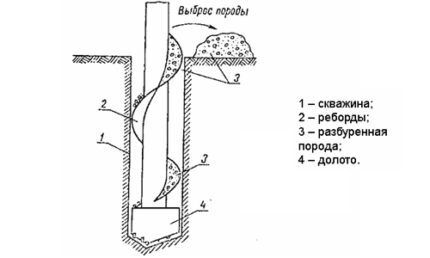
Pros and cons of using an auger
The auger drilling method allows you to construct a well as quickly as possible, provided that the size of the auger and the angle of inclination of the bit have been selected correctly.
The advantages of auger drilling include:
- the soil rises to the surface immediately during the drilling process;
- high speed of deepening into the ground without technological stops;
- there is no need to flush the wellbore;
- a compact auger unit or a manual auger can be used to drill inside the house (in the basement);
- there is no need to lift the first link to the surface and disassemble/assemble the drill string as with the core method.
The main disadvantage of auger drilling can be considered the inability to work on loose and very hard soils, but at the same time, an auger is an ideal tool for drilling in loamy, mixed (clay and sandy loam) and soft clay soils.
Another drawback that limits the use of an auger for constructing water-bearing wells is the need to use the shock-rope method to clean the shaft of dumped rock.
Similarity auger - coil Widely used in manual drilling. It destroys the rock in the same way and grabs it with its blades to extract it upward.
Characteristics of rotary drilling
Rotary drilling is a method of rotary-vibration drilling, in which soil destruction is carried out using a bit driven at the bottom of the well by the rotor of the drilling rig. The rotor rotates from a car engine or a separately installed electric motor via a drive shaft.
The developed soil is washed out of the well shaft using direct or reverse flushing. The washing solution can be supplied either by gravity or by a pumping station.
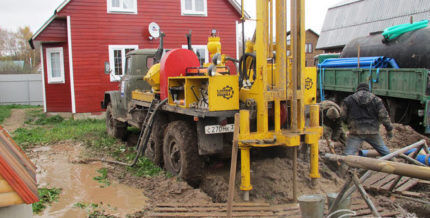
Rotary drilling is used to develop rocky and semi-rocky soils when constructing deep wells up to 150 m. A rotary drilling rig with a properly selected bit and weighted drill pipes copes well with rock formations.
Drilling experts recommend using this drilling method subject to the following conditions:
- The hydrogeological section of the site has been studied quite well. It is known that rocks will have to be drilled. The level of occurrence of the aquifer zone in bedrock is known.
- Groundwater has a pressure characteristic of artesian wells
- There is the possibility of uninterrupted delivery of technical water for flushing the well.
In the southern regions, rotary drilling can be carried out all year round, but in the northern climate, the use of this method is limited due to the possibility of freezing of the drilling fluid.
Equipment and tools used
Rotary drilling of water-bearing wells is carried out using a frame or lattice tower on which lifting equipment and other elements of the drilling rig are located. The derrick makes it possible to raise and lower drill strings into the well.
The rotary type drilling rig includes:
- frame or lattice tower;
- drive motor;
- rotor and drill string;
- pumping equipment and flushing liquid purification system;
- lifting equipment, pressure line, swivel, seals, etc.
Self-propelled rigs use the internal combustion engine of a vehicle as an engine, on the basis of which the drilling complex is located. In this case, the engine power regulates the speed of the drilling tool.
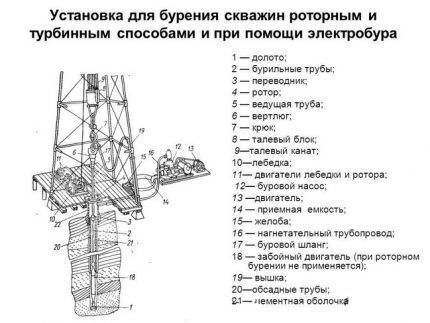
The rotor, using a gear device, transmits rotation to the drive pipe, which in turn transmits it to the main drilling tool - the bit.The chisel can have different shapes and is made of high-strength materials: composites, diamond-coated steel, etc.
For each type of soil, a special size and shape of the bit is selected, thereby ensuring high efficiency and speed of penetration.
The uniqueness of rotor technology
Rotary drilling of water wells is carried out in three stages:
- Destruction of rock using a chisel.
- The removal of destroyed rock to the surface by a stream of injected water.
- Strengthening the walls of the well with casing pipes.
Removal of destroyed soil is carried out by reverse or direct washing. The choice of flushing method depends on specific conditions: well depth, soil type, availability of the required volume of flushing water.
As a rule, private farms use direct circulation drilling technology, which includes the following steps:
- driving a large diameter bit into the ground;
- rotation of the bit under the influence of the rotor;
- installation of drill pipes and installation of weighted pipes between them and the bit;
- removal of waste soil by liquid pressure using a pump;
- installation of a casing pipe to prevent soil from falling inside the well;
- drilling with a bit of a smaller diameter and repeating the entire cycle.
During backflushing, soil is removed from the well through the pipes of the drill string, and the flushing fluid is poured between the walls of the well and the pipes.
Water flows by gravity into a pre-prepared reservoir, where it is cleaned from soil and sludge, and returns to the drill string for a new portion of waste rock.
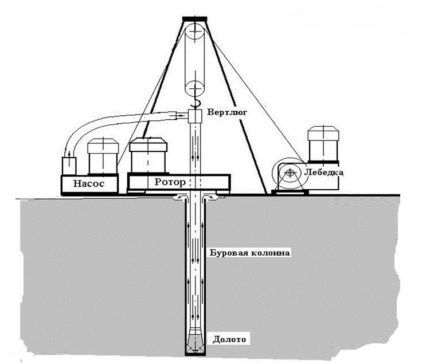
Advantages and disadvantages of rotary drilling
The main advantage of the rotary method is the ability to drill deep wells with water intake in fractured limestone.
In addition, this drilling method has the following advantages:
- high quality of opening of aquifer in bedrock;
- the possibility of constructing a large diameter well up to 200 cm;
- high drilling speed, low energy consumption.
A significant disadvantage of rotary drilling is the need to organize well flushing.
Which drilling method should I choose?
All considered methods of mechanical drilling are widely used for constructing water-bearing wells.
To summarize, we can say that:
- It is advisable to use core drilling for penetration in plastic clay soils.The core method is suitable for constructing most water intake workings; if necessary, it is used in conjunction with the shock-rope method.
- Auger drilling is similar in scope to the core method. It differs from it in poor quality of borehole cleaning and requires the mandatory use of a bailer or long-term flushing of the well before operation.
- Rotary drilling is the best option for drilling wells in rocky soils.
The cost of developing a well using a particular drilling method largely depends on what equipment is used, as well as on the drillability categories of the drilled rocks.
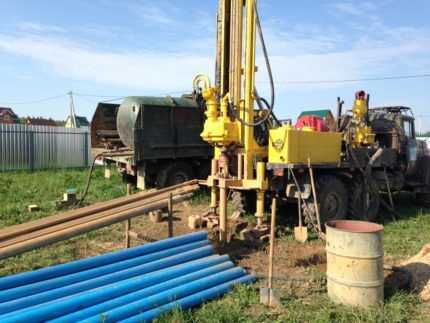
You can read about how to make a drilling rig with your own hands in another popular article our site.
Conclusions and useful video on the topic
Video #1. Demonstration of the principle of classic core drilling with core extraction using water pressure:
Video #2. Features of drilling a well with an auger:
Video #3. Core drilling of a well with flushing of the bottom and installation of double casing, the outer part of which is made of steel pipes, the inner part is made of polymer:
Drilling a water-bearing well is a labor-intensive process. Not only the speed of setting up an autonomous water source, but also the financial costs depend on the correctness of the chosen drilling method.
The first thing you should pay attention to when choosing a drilling method is the type of soil and the depth of the aquifer. Based on these parameters, you can choose the best option that will allow you to drill a well quickly and inexpensively.
Would you like to share the history of drilling a well on your own site or useful information on the topic of the article? Please leave comments in the block below. Here you can ask a question or point out controversial points in the text.




Once we decided to drill a well ourselves and regretted it very much, we only lost our time. The conclusion has matured that it is better to turn to drillers - specialists who have been involved in this business for many years. In addition to experience, they have equipment and tools for digging through different types of soil. But I have already, as they say, familiarized myself with the drilling process with my own eyes and even gained knowledge thanks to this site. The idea came up to try to drill a well again on my mother’s property)))
Drilling a well is quite difficult if you do everything wisely, go through it competently and arrange it afterwards. At first, I also thought of taking on this matter on my own, since I can do a lot of things with my hands, but I didn’t dare to venture here. As a result, I hired drillers, they did everything themselves, although I stood nearby almost the entire time and asked what and how for the future) The guys were good, they explained everything clearly.
I did everything right. Drilling a well yourself is a very labor-intensive process, moreover, with a large number of subtleties, without knowing which you can screw up. A few years ago, I helped a relative drill, so we went there almost every weekend for almost the entire summer as if it were work. I decided for myself - rather than waste time and nerves, it’s better to pay professionals, the main thing is to find normal ones.
The advantages of rotary include: it is possible to drill with a diameter of up to 200 cm, i.e.2 meters))) most likely up to 200 mm) on the big one, they drill in the direction of oil and gas bearing horizons (the so-called first meters of the well with a final bottom of 3-4-5 thousand meters) there is a drilling box 2 by 2 meters))